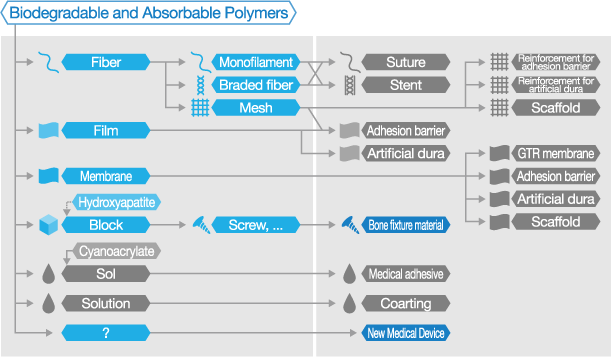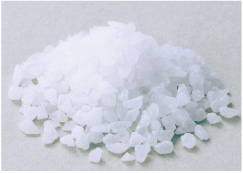Polylactide (Poly(lactic acid), PLA) is polymer obtained by the ring-opening polymerization of lactide (cyclic dimer of lactic acid) as monomer. Since lactide has 3 optical isomer as L-lactide, D-lactide, and DL-lactide, the polymers obtained from L-lactide, D-lactide, and DL-lactide are abbreviated to PLLA, PDLA, and PDLLA, respectively. The chemical properties of L-lactide and D-lactide are the same while their steric structures are different, PLLA polymer and PDLA polymer have the same characteristics. On the other hand, PDLLA polymer has sterically different structure with PLLA and PDLA polymers, so that the polymer shows the different characteristics with those polymers.

- Chemical name
- Poly(D-lactic acid)
Poly-D-lactide
Poly[oxy(1-methyl-2-oxoethylene)]
Poly[(3R,6R)-3,6-dimehthyl-1,4-dioxane-2,5-dione]
- Chemical formula
- −(C3H4O2)n−
−O−CO−CH(CH3)−
- Formula weight
- 72.06266
- CAS number
- 106989−11−1
- PoLyInfo PID
- P090176
- Characteristics
- Crystalline polymer, Transparent polymer, Heat-resistant
(In case of becoming stereo complexed PLA)
Typical specification of PDLA
The following shows the specification example of our PDLA polymer product.
- Testing item
- Specification
- Identification
- Same as the standard IR spectrum of PDLA
- Weight averaged
molecular weight(MW)
- MW = 200,000 − 280,000
- Melting point(Tm)
- Tm = 180 − 195 (℃)
- Particle size
- Not passing 500 µm mesh screen.
- Appearance
- No contamination by foreign objects
Normal coloring (white or beige or ivory) (Sensory test with eye)
If you have the specific requirement for PDLA polymer, please feel free to ask us.
Potential application of PDLA
PDLA polymer has the same characteristics and performance as PLLA, so that the polymer did not applied for medical devices. When the stereo complex PLA (
scPLA) is formed with PLLA and PDLA,
scPLA has higher melting point and superior mechanical properties than PLLA and PDLA. Therefore, the research and development of
scPLA has been continued.
Applicable examples of the medical device obtained from PDLA polymers are shown with color in follows:




